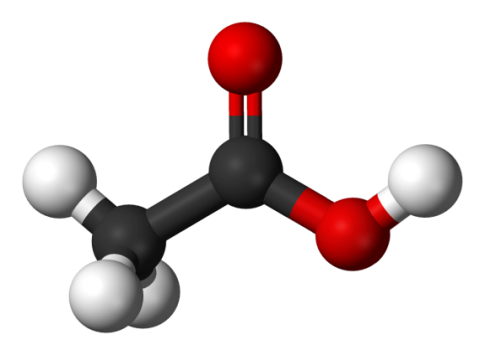What Is Acetic Acid
Acetic acid, also named as ethanoic acid, is a colourless liquid organic compound with the chemical formula CH3COOH and is the the second simplest but the most important of the carboxylic acids, which is an organic compound that contains a carboxyl group (C(O)OH). Acetic acid consists of two small functional groups, an acetyl group, which was symbolized as Ac sometimes and a hydroxyl group (AcOH).

Acetic acid is commonly ionised to acetate fully at physiological pHs. The acetyl group with chemical formula CH3CO, derived from Acetic acid contains a methyl group single-bonded to a carbonyl and is a functional group to all forms of life. Acetic acid is the central to the metabolism of carbohydrates and fats when bound to coenzyme A, which can react with carboxylic acids to form thioesters, thus functioning as an acyl group carrier. The Acetobacter genus and Clostridium acetobutylicum is the most notablyAcetic acid bacteria for producing and excreting the Acetic acid. In the industrial field, Acetic acid is produced both synthetically and by bacterial fermentation, which is a metabolic process that converts sugar to acids, gases or alcohol and about 75% of Acetic acid made for use in the chemical industry is made by the carbonylation , which is a kind of chemical reactions that introduce carbon monoxide into organic and inorganic substrates.
Analysis of Acetic Acids by HPLC
High-Performance Liquid Chromatography (HPLC) has become a crucial tool in organic chemistry analysis. Similarly, in food analysis, whether for residue or component analysis, HPLC has also become an indispensable analytical instrument. The analysis of acetic acids by HPLC is a highly effective and widely utilized method for separating and quantifying various acetic acid compounds in diverse sample matrices. HPLC offers several advantages for this purpose. It allows for precise quantification with excellent sensitivity and selectivity, thanks to the availability of different detection techniques such as UV, refractive index, or mass spectrometry. Additionally, HPLC offers versatility in mobile phase composition and column choice, making it adaptable to a broad range of acetic acid species and sample types. Its ability to handle both liquid and solid samples, coupled with the potential for derivatization to enhance sensitivity, makes HPLC a valuable tool in research, quality control, and environmental monitoring for acetic acid analysis.
Our Acetic Acid Quantification Platform
Creative Proteomics can utilize High-Performance Liquid Chromatography (HPLC) and Liquid Chromatography-Mass Spectrometry (LC-MS) for the efficient and precise detection of acetic acid content. This method is straightforward and rapid.
Sample requirement
| Sample Type | Minimum Amount | Typical Amount |
|---|---|---|
| Animal and Clinical Tissue Samples | 5-10mg | 50mg |
| Blood Samples (Serum, Plasma, Whole Blood) | 10μL | 50μL |
| Urine Samples | 10μL | 50μL |
| Fecal and Gastrointestinal Content | 10mg | 25mg |
| Fluid Samples (Cerebrospinal Fluid, Saliva, etc.) | 5-10μL | 25μL |
| Plant Tissue Samples (Roots, Stems, Leaves, Flowers, Fruits, etc.) | 10mg | 50mg |
| Cell and Microbial Cells | 1*10^5 cells | 1*10^6 cells |
| Culture Media and Fermentation Broth | 10μL | 50μL |
Our Advanced Detection Platforms:
The High-Performance Liquid Chromatography (HPLC) Detection Platform is furnished with cutting-edge Agilent HPLC systems that offer compatibility with a range of detectors, including UV-Visible Diode Array Detectors, Evaporative Light Scattering Detectors, and Fluorescence Detectors (FLD).
LC-MS Detection Platform: Features state-of-the-art instruments such as the Agilent 6495B Triple Quadrupole LC-MS, Q-Exactive-TM Mass Spectrometry System, Waters Micromass Quattro Micro API LC-MS-MS, and AB Triple-TOF® 5600+ LC-MS-MS System.
Gas Chromatography-Mass Spectrometry (GC-MS) Detection Platform: Employing the Gas Chromatography-Mass Spectrometry (GC-MS) technique, this analytical platform is adept at discerning thermally stable, volatile, and vaporizable compounds. It exhibits the advantages of swift detection coupled with precision in result generation.
Biochemical Detection Platform: Primarily employs chemical methods, isotope labeling, and spectroscopic analysis to analyze certain biomacromolecules such as nucleic acids, proteins, metabolic enzymes, etc. This allows for the validation of molecular structures and content of these substances.
Inductively Coupled Plasma Mass Spectrometry (ICP-MS) Detection Platform: Employs the ICP-MS technique to detect a diverse array of metallic elements, encompassing cobalt, cadmium, zinc, nickel, mercury, iron, selenium, boron, and various others, while concurrently delivering isotopic data.







